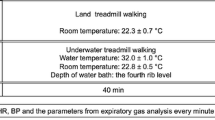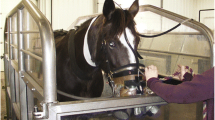Summary
Fifteen unconditioned young men, who were similar in maximal aerobic power (VO2 max), were divided into three groups (n=5 each) and physically trained for one month on a cycle ergometer either on land (I) or immersed to the neck in water of either 32‡ C (II) or 20‡ C (III) to determine if physical training (PT) in water and air differ. PT consisted of one-hour daily exercise, 5 times/wk, with exercise intensity readjusted each week to maintain a constant training stimulus of ~ 75% VO2 max (determined on land). Throughout the training period, heart rates (fc) of III averaged 20 and 10 beats·min−1 less than I and II, respectively, despite working at the same VO2 and % VO2 max. Training elicited a 16% increase in VO2 max in I compared to increases of 13 and 15% for II and III, respectively. It was concluded that PT in water produces similar physiological adaptations as does training on land. In cold water, VO2 max is improved despite training with fc significantly lower than that on land.
Similar content being viewed by others
References
Agostoni E, Gurtner G, Torri G, Rahn H (1966) Respiratory mechanics during submersion and negative-pressure breathing. J Appl Physiol 21: 251–258
Arborelius M Jr, Balldin UI, Lilja B, Lundgren CEG (1972) Hemodynamic changes in man during immersion with the head above water. Aerosp Med 43: 592–598
Bergh U, Ekblom B (1979) Physical performance and peak aerobic power at different body temperatures. J Appl Physiol: Respirat Environ Exercise Physiol 46: 885–889
Bergh U, Hartley H, Landberg L, Ekblom B (1979) Plasma norepinephrine concentration during submaximal and maximal exercise at lowered skin and core temperatures. Acta Physiol Scand 106: 383–384
Craig AB Jr, Dvorak M (1969) Comparison of exercise in air and in water of different temperature. Med Sci Sports 1: 124–130
Davies M, Ekblom B, Bergh U, Kanstrup-Jensen IL (1975) The effects of hypothermia on submaximal and maximal work performance. Acta Physiol Scand 95: 201–202
Dressendorfer RH, Morlock JF, Baker DG, Hong SK (1976) Effects of a head-out water immersion on cardio-respiratory responses to maximal cycling exercise. Undersea Biomed Res 3: 177–187
Kamon E, Pandolf KB (1972) Maximal aerobic power during laddermill climbing, uphill running and cycling. J Appl Physiol 32: 467–473
McArdle WD, Magel JR, Lesmes GS, Pechar GS (1976) Metabolic and cardiovascular adjustment to work in air and water at 18, 25 and 33‡ C. J Appl Physiol 40: 85–90
Moore TO, Bernauer EM, Seto G, Park YS, Hong SK, Hayashi EM (1970) Effect of immersion at different water temperatures on graded exercise performance in man. Aerosp Med 41: 1404–1408
Nadel ER, Holmer I, Bergh U, åstrand PO, Stolwijk JAJ (1974) Energy exchanges of swimming man. J Appl Physiol 36: 465–471
Nielsen B, Davies CTM (1976) Temperature regulation during exercise in water and air. Acta Physiol Scand 98: 500–508
Pechar GS, McArdle WD, Katch FI, Magel JR, Deluca J (1974) Specificity of cardiorespiratory adaptation to bicycle and treadmill training. J Appl Physiol 36: 753–756
Pirnay F, Deroanne R, Petit JM (1977) Influence of water temperature on thermal, circulatory and respiratory responses to muscular work. Eur J Appl Physiol 37: 129–136
Rennie DW, di Prampero P, Cerretelli P (1971) Effects of water immersion on cardiac output, heart rate and stroke volume of men at rest and during exercise. Med Sport (Turin) 24: 223–228
Rowell LB (1974) Human cardiovascular adjustment to exercise and thermal stress. Physiol Rev 54: 75–159
Shapiro Y, Avellini BA, Toner MM, Pandolf KB (1981) Modification of the Monark bicycle ergometer for underwater exercise. J Appl Physiol: Respirat Environ Exercise Physiol 50: 679–683
Taylor HL, Buskirk E, Henschel A (1955) Maximal oxygen intake as an objective measure of cardio-respiratory performance. J Appl Physiol 8: 73–80
Author information
Authors and Affiliations
Rights and permissions
About this article
Cite this article
Avellini, B.A., Shapiro, Y. & Pandolf, K.B. Cardio-respiratory physical training in water and on land. Europ. J. Appl. Physiol. 50, 255–263 (1983). https://doi.org/10.1007/BF00422164
Accepted:
Issue Date:
DOI: https://doi.org/10.1007/BF00422164




